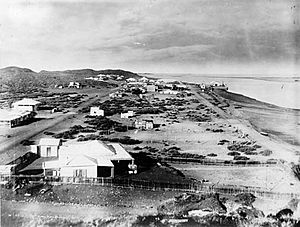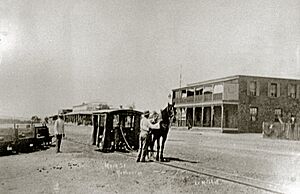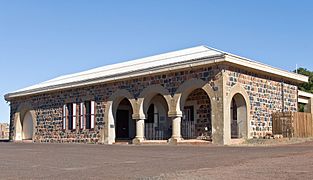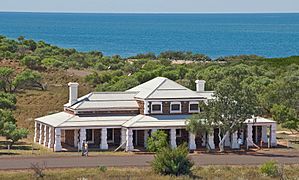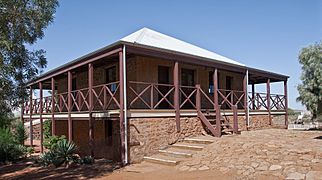Cossack, Western Australia facts for kids
Quick facts for kids CossackWestern Australia |
|||||||||
|---|---|---|---|---|---|---|---|---|---|
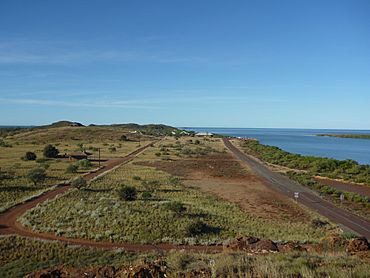
The Cossack townsite, viewed from Nannygoat Hill.
|
|||||||||
| Established | 1863 1871 (renamed) |
||||||||
| Postcode(s) | 6720 | ||||||||
| Elevation | 7 m (23 ft) | ||||||||
| Area | [convert: needs a number] | ||||||||
| Location | 34 km (21 mi) from Karratha | ||||||||
| LGA(s) | City of Karratha | ||||||||
| State electorate(s) | North West Coastal | ||||||||
| Federal Division(s) | Durack | ||||||||
|
|||||||||
| Designations | |
|---|---|
| Designated | 21 April 2006 |
| Reference no. | 3239 |
Cossack, also called Bajinhurrba by the Ngarluma people, is a historic ghost town in Western Australia. It is about 1,480 km (920 mi) north of Perth and 15 km (9.3 mi) from Roebourne. Cossack sits on Butcher Inlet near the Harding River. The nearby town is Wickham.
The area is very important to the Ngarluma people, who are the traditional owners. They have lived here for thousands of years. The river mouth is still a key place for fishing and hunting traditional foods. You can also find many ancient rock carvings in the area.
Cossack is known as the starting point for Western Australia's pearling industry. It was home to the pearling boats until the 1880s. The town was left empty after the 1940s. Many old stone buildings remain, some of which are protected by the National Trust. Cossack is now a "museum town."
Today, Cossack is a popular spot for tourists. It is close to the ocean and fresh water. Visitors can camp or stay in the historic buildings. Bookings are made through the Ngarluma and Yindjibarndi Foundation Ltd (NYFL), which manages the town.
Contents
History of Cossack
Before Cossack was built, the land belonged to the Ngarluma, an Aboriginal group.
In May 1863, Walter Padbury brought his animals to the mouth of the Harding River. This was near where Cossack is now. The town was first called Tien Tsin, after the ship that brought Padbury. In December 1871, the state's governor arrived on a ship called HMS Cossack. The town then changed its name to Cossack in 1872.
Cossack was the first port in the North West. It was very important for growing the pastoral industry (raising sheep and cattle) in the region. The harbour that served the town was first called Tien Tsin Harbour. Later, it was renamed Port Walcott.
Pearling Industry
In 1866, the town of Roebourne was created, and the pearling industry began. Cossack was the main hub for pearling in Western Australia. It was home to the pearling fleet until the 1880s. Many small boats searched for pearl shells off the Port Walcott coast. They used Aboriginal workers, including women and children.
By 1869, 14 small boats were pearling, each with a crew of Europeans and Aboriginal people. By the early 1870s, up to 80 pearling boats were working there. The pearling industry also brought many people from Asia, including Japanese, Chinese, and Malay workers. By 1895, many Asian workers were employed on 57 vessels in Cossack. Because of this, an Asian area called "Chinatown" was set up in town.
In 1881, a strong cyclone hit Cossack. It damaged the town and all the pearling boats. By 1886, the main pearling industry moved to Broome. This was because many pearl beds in the Cossack area were running out.
Causeway and Tramway
In the 1870s, a causeway was built across the salt flats. This causeway still provides the only road access to Cossack.
A horse-drawn tram line was finished in 1887. It connected Roebourne and Cossack. This was the same year Cossack became its own town, and a gold rush began in the north-west.
Why the Town Declined
After the pearling industry moved to Broome and the gold rush ended, fewer people lived in Cossack. The harbour was not deep enough for the larger ships of the early 1900s. Between 1902 and 1904, a new jetty was built at Point Samson. In 1910, the port moved there, and Cossack was no longer its own municipality.
Wool and pearls were loaded onto smaller boats called lighters. These lighters took the goods to bigger ships 3 mi (4.8 km) offshore. These ships then carried the cargo to England. By the 1940s or 1950s, the town was completely abandoned.
The area often gets strong storms and cyclones. These storms caused a lot of damage over the years. Even so, Cossack was an important northern port for a long time. Today, Cossack is a Museum Town.
Location and Geography
Cossack is located on Butcher Inlet, at the mouth of the Harding River. You reach it by a paved road that crosses tidal salt flats. The land around Cossack is mostly flat, with some rocky hills. The plants are mainly grass, spinifex, and small shrubs. There are also mangrove trees along the shoreline.
The main road from Roebourne goes past Wickham and the Cape Lambert iron ore port. It ends at the fishing town of Point Samson. You cannot see Cossack from the main road. It only appears as the road goes around Nanny Goat Hill.
The old town site is surrounded by Nanny Goat Hill, Tien Tsin Lookout, and Butcher Inlet. There are also several beaches on small islands nearby. If you drive past the town, the road goes up to the Reader Head Lookout. From there, you can see amazing views of the coastline.
Heritage Buildings
Most of the main stone buildings in Cossack were built in the 1880s. Public buildings from the 1890s show a special style used in the state. These buildings are important for their history and architecture.
Around 1900, Cossack had two hotels: the Weld and the White Horse.
Cemetery
Cossack has a small cemetery with separate areas for Europeans and Japanese. The pearling industry in the 1800s was very dangerous. Many pearlers lost their lives. Those buried in the Japanese cemetery were mostly divers and others who worked in pearling. Many Aboriginal people were also lost at sea.
The first burial in the cemetery is thought to be in 1869. At least 41 Europeans and seven Japanese people were buried there. The last recorded burial was in 1915.



